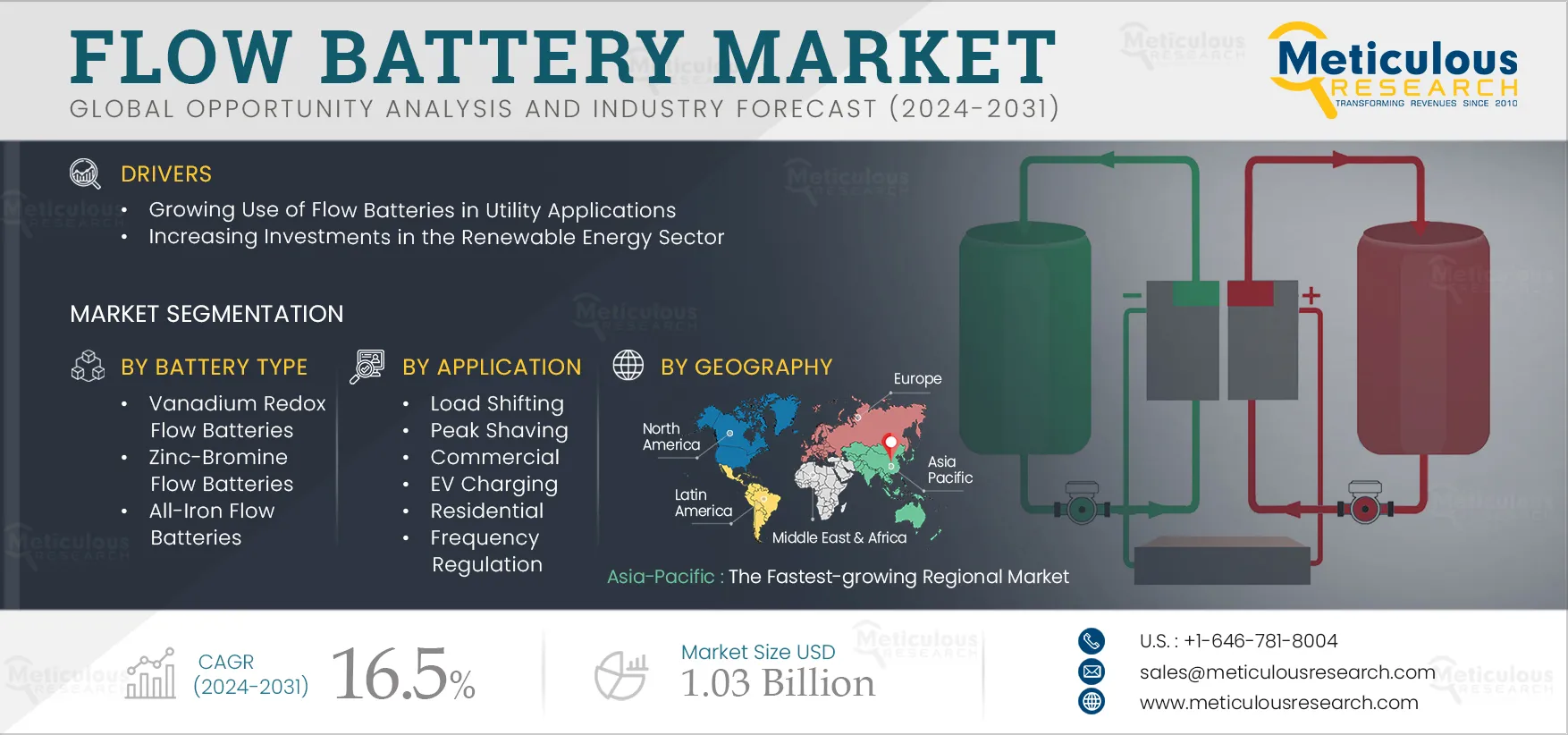The Flow Battery Market is expected to reach $1.03 billion by 2031 at a CAGR of 16.5% during 2024–2031. The growth of the flow batteries market is mainly driven by the high demand for flow batteries in utility applications and increasing investments in renewable energy. However, the lack of standardization in the development of flow battery systems and the high initial costs of flow battery manufacturing restrain the growth of this market.
Furthermore, technological innovation and the growing demand for backup power among data centers are expected to offer significant growth opportunities for players operating in the flow batteries market. However, the declining rate of flow battery deployment and disruptions in the supply of raw materials for battery manufacturing may hinder the growth of this market. Additionally, advancements in flow batteries and energy storage as a service are prominent trends in the flow batteries market.
Here are the top 10 companies operating in the Flow Battery Market
Sumitomo Electric Industries, Ltd.
Sumitomo Electric Industries, Ltd. offers optical transceiver modules used in high-speed optical communication systems. The company offers environment & energy, infocommunication, automotive, electronics, and industrial materials, among other products. The company operates in the market through five business segments—Automotive, Environment & Energy, Industrial Materials & Others, Electronics, and Infocommunications.
With its subsidiaries and strong distribution network, Sumitomo Electric Industries, Ltd. has a geographic presence across Asia, the Americas, Europe, and other regions. SEI Incorporated (Philippines), Sumitomo Electric Automotive Products Pte. Ltd. (Singapore), Sumitomo Electric Ltd. (Thailand), and Sumitomo Electric Interconnect Products Sdn, Bhd (Malaysia) are some of the company’s subsidiaries.
Invinity Energy Systems PLC
Invinity Energy Systems PLC is engaged in the manufacture and sale of vanadium flow battery systems. The company also provides installation and other services. Invinity Energy Systems PLC offers vanadium flow batteries for various applications, including utilities & developers, commercial & industrial, off-grid & microgrid, projects & case studies, and Longer Duration Energy Storage (LODES).
The company operates through three reportable business segments, namely Battery Systems and Associated Control Systems, Integration and Commissioning, and Other Services. Invinity has operations in the U.K., Canada, the U.S., Australia, and China.
ESS Tech, Inc. offers long-duration energy storage and specializes in iron flow battery technology. The company leverages technology that uses earth-abundant iron, salt, and water to deliver environmentally safe solutions capable of providing up to 12 hours of flexible energy capacity for commercial and utility-scale energy storage applications.
The company offers flow batteries for various applications, including utility-scale and commercial & industrial (C&I) applications, Microgrids, DERMS, and VPPs.
Redflow Limited
Redflow Limited is a leader in the renewable energy transition, delivering one of the world’s safest and cleanest energy storage solutions. Redflow offers leading solutions for reliable and sustainable energy storage. The company provides Battery, QuadPod, and Energy Pod, among other solutions. Redflow’s offerings serve various applications, including commercial and industrial, telco/utility, remote/off-grid, and grid services.
With over ten years of experience in deploying energy storage and supporting critical infrastructure, Redflow’s innovative technology has been proven in the harshest of conditions. The company provides zinc-bromine flow batteries, which are among some of the world’s smallest, safest, most scalable, and sustainable energy storage solutions. The batteries have a long-life design and chemistry that makes use of cost-effective, abundant, fire-safe, and low-toxicity materials.
StorEn Technologies, Inc.
StorEn Technologies, Inc. is a private company that delivers batteries with superior performance at lower costs and fulfills the demand for more efficient and cost-effective energy storage. The company offers products for residential, industrial, and telecom, among other applications.
Largo Inc.
Largo Inc. is a global leader in the vanadium sector. The company offers products, materials, and solutions for a low-carbon future. Largo Inc. provides various solutions, including clean energy storage, vanadium, and large physical vanadium. The company’s products serve applications such as renewable energy integration, utilities/grid optimization, microgrids, commercial and industrial energy independence, and EV charging integration.
ViZn Energy, Inc.
ViZn Energy, Inc. is a private energy company that develops sustainable energy storage solutions for transportation and smart grid applications. The company’s energy storage solutions serve various applications, including utility T&D, utility-scale wind & solar, military, commercial and industrial, and public sector applications.
VRB ENERGY
VRB ENERGY is a private company, a global clean technology innovator, and a leader in vanadium redox batteries. The company has developed the most reliable, longest-lasting vanadium flow battery in the world, with more than 30 megawatt-hours installed and in construction globally and over 800,000 hours of demonstrated performance. The company’s products cater to renewable energy, utilities, commercial, and microgrids, among other applications.
Primus Power Solutions
Primus Power Solutions is a private company offering low-cost, long-life, and long-duration energy storage systems. The company caters to industrial, commercial, renewables, and utilities, among other sectors. Primus Power provides flow batteries to U.S. and international commercial/industrial, data center, microgrid, and utility customers.
SCHMID Energy Systems GmbH
SCHMID Energy Systems GmbH is a privately held company that provides flow batteries offering maximum performance, scalability, safety, and recyclability. The company offers various products and solutions, including telecom storage, storage containers, building-integrated storage, and large-scale storage. The company’s products serve applications such as balancing, E-mobility, smart grid, peak shaving, off-grid, and renewable integration.
























